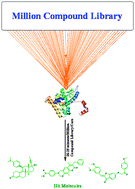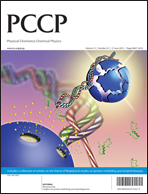A rapid identification of hit molecules for target proteins via physico-chemical descriptors†
Abstract
We report here a novel computationally fast protocol (RASPD) for identifying good candidates for any target protein from any molecule/million molecule database. A QSAR-type equation sets up the extent of complementarity of the physico-chemical properties of the target protein and the candidate molecule and an estimate of the binding energy is generated. A correlation coefficient of 0.84 and an average error ±1.45 kcal mol−1 are obtained for the calculated protein–ligand binding energies against experiment for more than 380 protein–ligand complexes. RASPD is seen to perform better than other popular scoring functions in predicting binding energies. The most interesting feature of this methodology is that it takes only a fraction of a second for calculating the binding energy of any ligand without docking in the active site of the target protein as opposed to several minutes for regular docking and scoring methods, while the accuracy in sorting good candidates remains comparable to that of conventional techniques. An entire million compound library, a (∼105 compound) natural product library and a (∼105 compound) NCI database can be scanned against a specified target protein within a few minutes for identifying hit molecules. The RASPD methodology is freely accessible at http://www.scfbio-iitd.res.in/software/drugdesign/raspd2.jsp.


 Please wait while we load your content...
Please wait while we load your content...